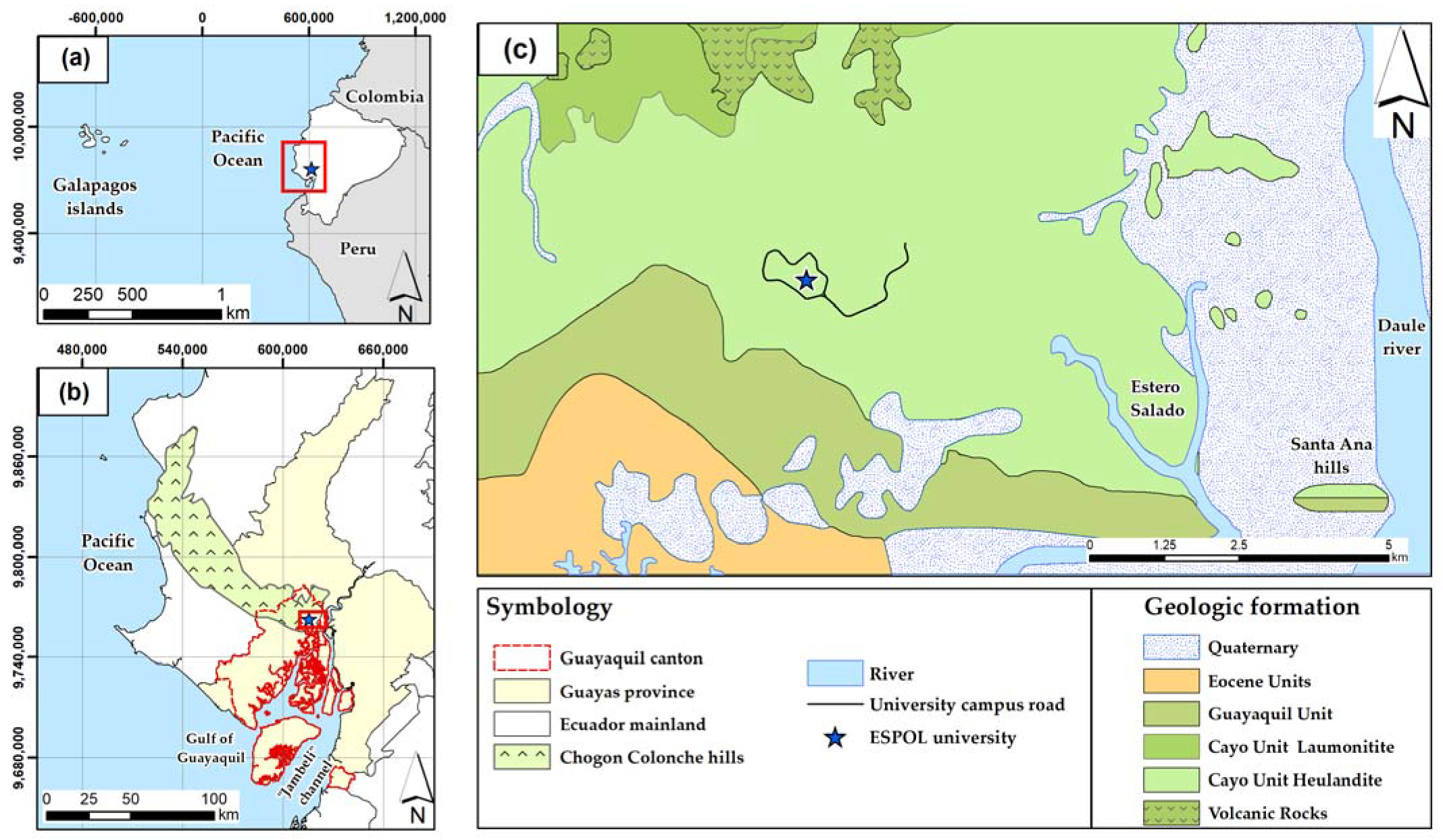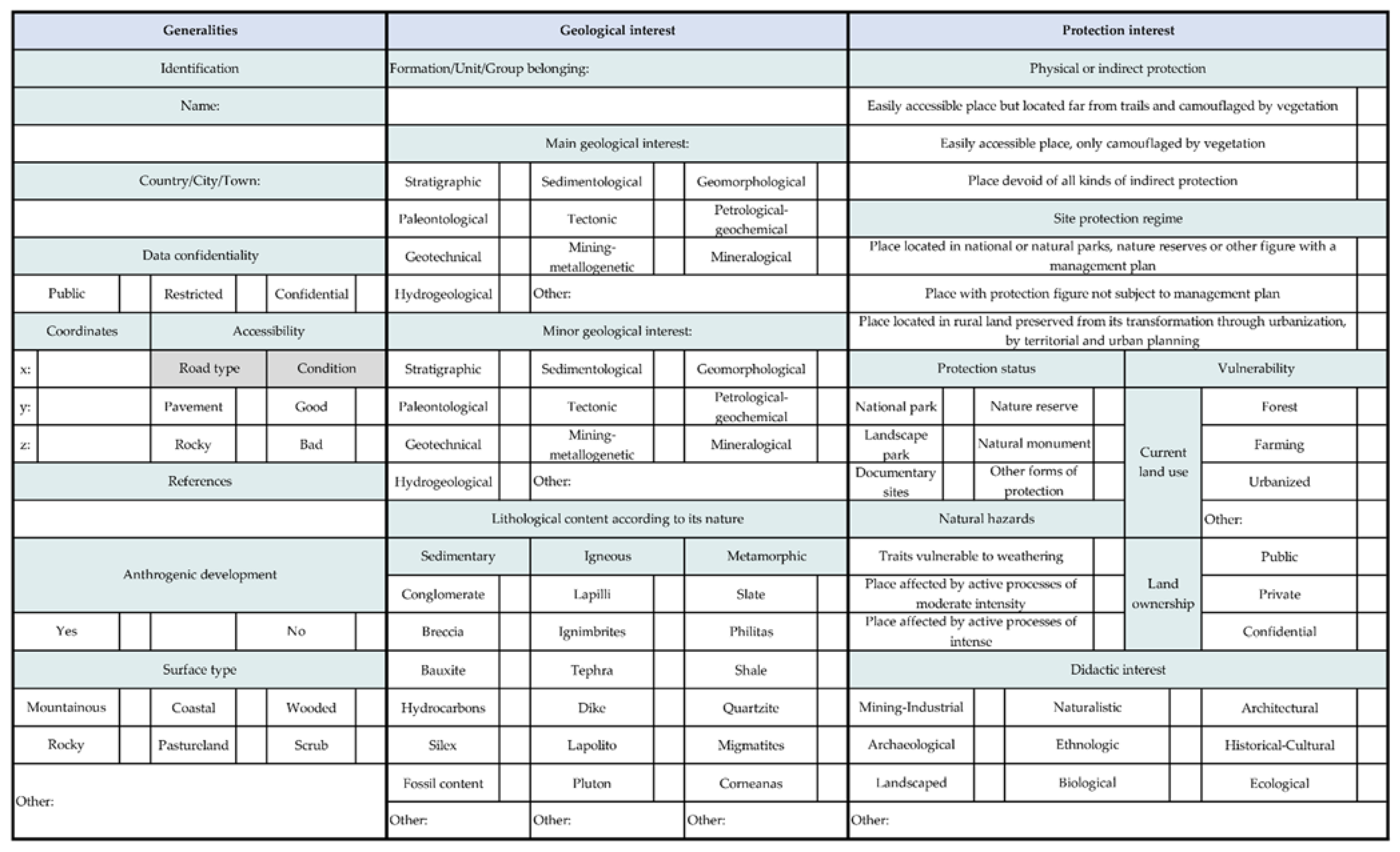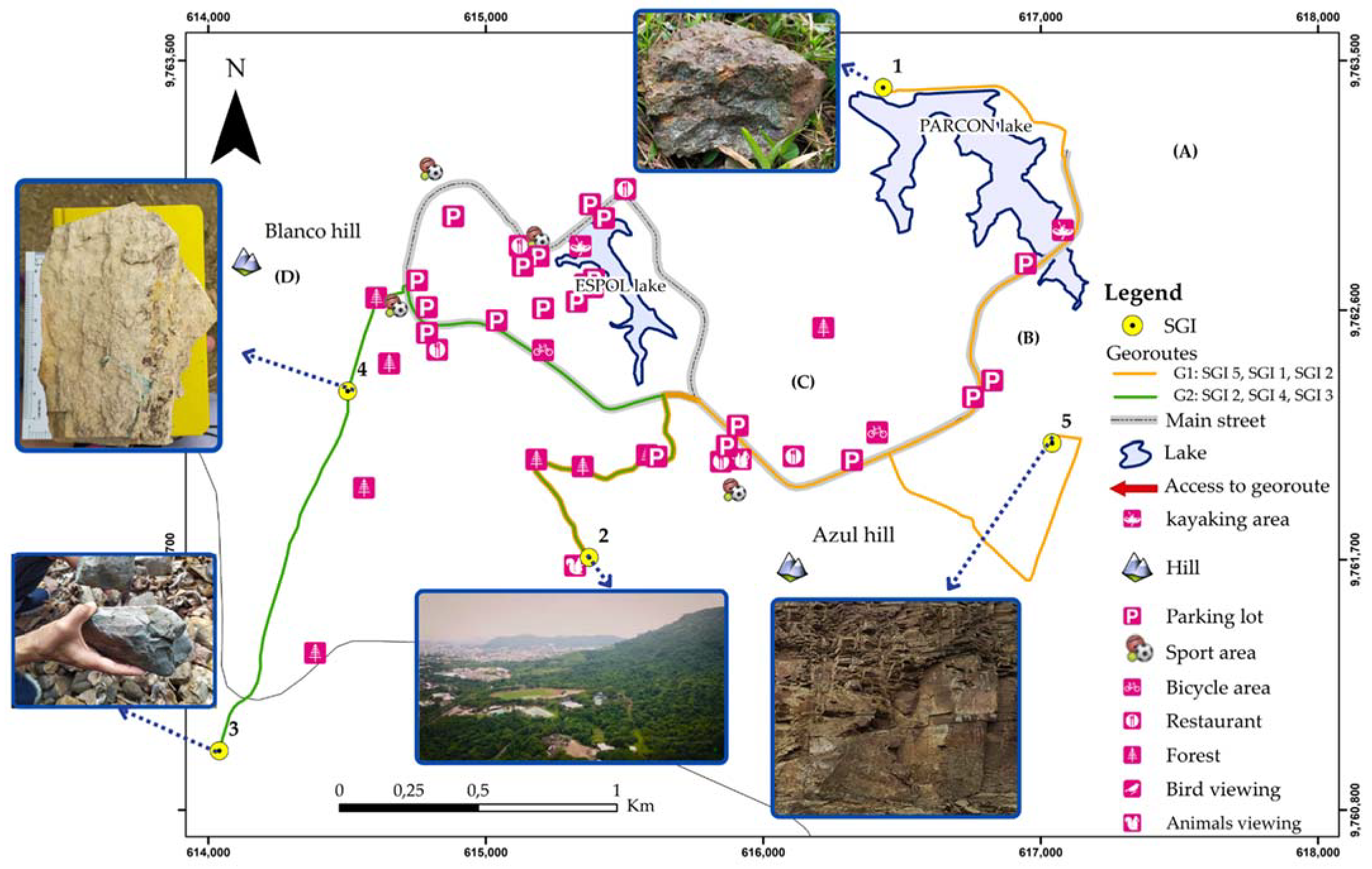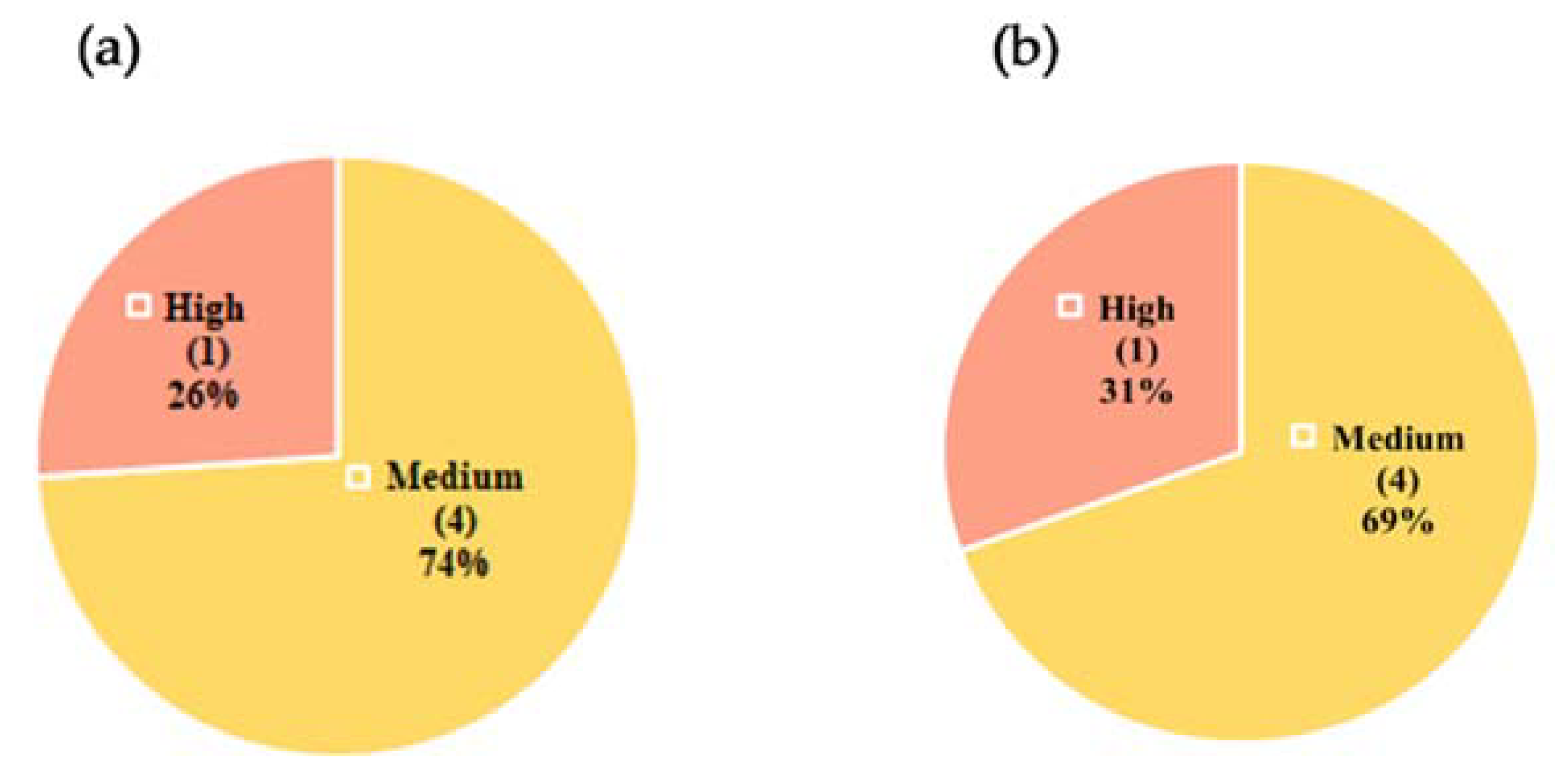Sites of Geological Interest Assessment for Geoeducation Strategies, ESPOL University Campus, Guayaquil, Ecuador
Abstract
:1. Introduction
2. Geographical and Geologic Setting
3. Materials and Methods
3.1. Phase I: Inventory and Initial Selection of Sites of Geological Interest
3.2. Phase II: Characterisation and Semi-Quantitative Geosites Assessment
3.3. Phase III: Qualitative Assessment Using SWOT Analysis
4. Results
4.1. Sites of Geological Interest: Identification, Description, and Semi-Quantitative Assessment
4.2. Qualitative Assessment: SWOT Analysis
- Guarantee that the number of visitors does not exceed the maximum load capacity of the sites of geological interest and the elements of native or endemic biodiversity of the campus.
- Promote the quintuple helix model of innovation [51] on campus by strengthening the circular economy system in all the axes of its management, integrating the value of geological heritage.
- Articulate nature interpretation programs with geological heritage values by creating games or augmented reality that highlights the main geological interest of the sites.
- Include geoeducation as part of the campus environmental training program.
- Launch geoeducational souvenirs at specific points of the campus routes to awaken their interest in exploring the sites and raising awareness about the importance of geoscience.
- Implementation of a geo-mining museum and itineraries within the campus as part of the earth sciences education program.
5. Interpretation of the Results and Discussion
6. Conclusions
- Develop a geoconservation plan, ensuring that the number of visitors does not exceed the maximum load capacity of the sites of geological interest and the biodiversity elements of the campus.
- Integrate the value of the geological heritage in the quintuple helix model of campus innovation by strengthening a circular economy system in all the axes of its management.
- Articulate existing ecological interpretation programs with geological heritage values by creating games, museums, itineraries, launching geoeducational souvenirs, or developing educational content using augmented reality that highlights the sites’ main geological interest and surroundings.
- Include geoeducation as part of the campus environmental training program.
Author Contributions
Funding
Institutional Review Board Statement
Informed Consent Statement
Data Availability Statement
Acknowledgments
Conflicts of Interest
References
- Reynard, E.; Brilha, J. Geoheritage: A Multidisciplinary and Applied Research Topic. In Geoheritage Assessment, Protection, and Management; Reynard, E., Brilha, J., Eds.; Elsevier: Amsterdam, The Netherlands, 2018; pp. 3–9. [Google Scholar]
- United Nations Educational, Scientific and Cultural Organization (UNESCO) List of Geoparks & Regional Networks. Available online: https://en.unesco.org/global-geoparks/list (accessed on 6 November 2021).
- Gray, M. Geodiversity. In Geoheritage; Elsevier: Amsterdam, The Netherlands, 2018; pp. 13–25. [Google Scholar]
- Catana, M.M.; Brilha, J.B. The Role of UNESCO Global Geoparks in Promoting Geosciences Education for Sustainability. Geoheritage 2020, 12, 1. [Google Scholar] [CrossRef]
- Gordon, J.E.; Crofts, R.; Díaz-Martínez, E. Geoheritage Conservation and Environmental Policies. In Geoheritage; Elsevier: Amsterdam, The Netherlands, 2018. [Google Scholar]
- Zafeiropoulos, G.; Drinia, H.; Antonarakou, A.; Zouros, N. From Geoheritage to Geoeducation, Geoethics and Geotourism: A Critical Evaluation of the Greek Region. Geosciences 2021, 11, 381. [Google Scholar] [CrossRef]
- Brilha, J. Geoheritage: Inventories and Evaluation. In Geoheritage Assessment, Protection, and Management; Reynard, E., Brilha, J., Eds.; Elsevier: Amsterdam, The Netherlands, 2018; pp. 69–85. [Google Scholar]
- Herrera-Franco, G.; Montalván-Burbano, N.; Carrión-Mero, P.; Apolo-Masache, B.; Jaya-Montalvo, M. Research Trends in Geotourism: A Bibliometric Analysis Using the Scopus Database. Geosciences 2020, 10, 379. [Google Scholar] [CrossRef]
- Hose, T.A. 3G’s for Modern Geotourism. Geoheritage 2012, 4, 7–24. [Google Scholar] [CrossRef]
- Brocx, M.; Semeniuk, V. The ‘8Gs’—A Blueprint for Geoheritage, Geoconservation, Geo-Education and Geotourism. Aust. J. Earth Sci. 2019, 66, 803–821. [Google Scholar] [CrossRef]
- Sellier, D. La Vulgarisation Du Patrimoine Géomorphologique: Objets, Moyens et Perspectives. Bull. L’Association Geogr. Fr. 2009, 86, 67–81. [Google Scholar] [CrossRef]
- Arrad, T.Y.; Errami, E.; Ennih, N.; Ouajhain, B.; Ettachfini, E.M.; Bouaouda, M.S. From Geoheritage Inventory to Geoeducation and Geotourism Implications: Insight from Jbel Amsittene (Essaouira Province, Morocco). J. Afr. Earth Sci. 2020, 161, 103656. [Google Scholar] [CrossRef]
- Coratza, P.; Hobléa, F. The Specificities of Geomorphological Heritage. In Geoheritage; Elsevier: Amsterdam, The Netherlands, 2018. [Google Scholar]
- Prosser, C.D.; Díaz-Martínez, E.; Larwood, J.G. The Conservation of Geosites. In Geoheritage; Elsevier: Amsterdam, The Netherlands, 2018. [Google Scholar]
- Carrión-Mero, P.; Montalván-Burbano, N.; Herrera-Narváez, G.; Morante-Carballo, F. Geodiversity and Mining towards the Development of Geotourism: A Global Perspective. Int. J. Des. Nat. Ecodyn. 2021, 16, 191–201. [Google Scholar] [CrossRef]
- Reynard, E.; Giusti, C. The Landscape and the Cultural Value of Geoheritage. In Geoheritage; Elsevier: Amsterdam, The Netherlands, 2018. [Google Scholar]
- García-Cortés, Á.; Carcavilla Urquí, L.; Apoita Mugarza, B.; Arribas, A.; Bellido, F.; Barrón, E.; Delvene, G.; Díaz-Martínez, E.; Díez, A.; Durán, J.J.; et al. Documento Metodológico Para La Elaboración del Inventario Español de Lugares de Interés Geológico (IELIG). Propuesta Para La Actualización Metodológica; Instituto Geológico y Minero de España: Madrid, Spain, 2013; pp. 1–64. [Google Scholar]
- Brilha, J. Inventory and Quantitative Assessment of Geosites and Geodiversity Sites: A Review. Geoheritage 2016, 8, 119–134. [Google Scholar] [CrossRef] [Green Version]
- Vujičić, M.D.; Vasiljević, D.A.; Marković, S.B.; Hose, T.A.; Lukić, T.; Hadžić, O.; Janićević, S. Preliminary Geosite Assessment Model (GAM) and Its Application on Fruška Gora Mountain, Potential Geotourism Destination of Serbia. Acta Geogr. Slov. 2011, 51, 361–376. [Google Scholar] [CrossRef]
- Bruschi, V.M.; Coratza, P. Geoheritage and Environmental Impact Assessment (EIA). In Geoheritage; Elsevier: Amsterdam, The Netherlands, 2018. [Google Scholar]
- Dunlop, L.; Larwood, J.G.; Burek, C.V. Geodiversity Action Plans—A Method to Facilitate, Structure, Inform and Record Action for Geodiversity. In Geoheritage; Elsevier: Amsterdam, The Netherlands, 2018. [Google Scholar]
- Franco, G.H.; Mero, P.C.; Carballo, F.M.; Narváez, G.H.; Bitar, J.B.; Torrens, R.B. Strategies for the Development of the Value of the Mining-Industrial Heritage of the Zaruma-Portovelo, Ecuador, in the Context of a Geopark Project. Int. J. Energy Prod. Manag. 2020, 5, 48–59. [Google Scholar] [CrossRef]
- Newsome, D.; Dowling, R. Geoheritage and Geotourism. In Geoheritage; Elsevier: Amsterdam, The Netherlands, 2018. [Google Scholar]
- Carrión-Mero, P.; Morante-Carballo, F.; Apolo-Masache, B. Evaluation of Geosites as an Alternative for Geotouristic Development in Guayaquil, Ecuador. WIT Trans. Ecol. Environ. 2020, 241, 45–56. [Google Scholar] [CrossRef]
- Henriques, M.H.; Castro, A.R.S.F.; Félix, Y.R.; Carvalho, I.S. Promoting Sustainability in a Low Density Territory through Geoheritage: Casa Da Pedra Case-Study (Araripe Geopark, NE Brazil). Resour. Policy 2020, 67, 101684. [Google Scholar] [CrossRef]
- Wang, J.; Zouros, N. Educational Activities in Fangshan UNESCO Global Geopark and Lesvos Island UNESCO Global Geopark. Geoheritage 2021, 13, 51. [Google Scholar] [CrossRef]
- Dong, H.; Song, Y.; Chen, T.; Zhao, J.; Yu, L. Geoconservation and Geotourism in Luochuan Loess National Geopark, China. Quat. Int. 2014, 334–335, 40–51. [Google Scholar] [CrossRef]
- INABIO Ecuador, País Inmenso en Biodiversidad—Biodiversidad—Instituto Nacional de Biodiversidad. Available online: http://www.biodiversidad.gob.ec/ecuador-pais-inmenso-en-biodiversidad/ (accessed on 7 November 2021).
- Berrezueta, E.; Sánchez-Cortez, J.L.; Aguilar-Aguilar, M. Inventory and Characterization of Geosites in Ecuador: A Review. Geoheritage 2021, 13, 93. [Google Scholar] [CrossRef]
- Carrión-Mero, P.; Morante-Carballo, F. The Context of Ecuador’s World Heritage, for Sustainable Development Strategies. Int. J. Des. Nat. Ecodyn. 2020, 15, 39–46. [Google Scholar] [CrossRef]
- Preprint, E.; Ching-Ávalos, S.; Guzmán-Garaicoa, I.; Velástegui-Montoya, A.; Chang-Silva, R.; Herrera-Matamoros, V. Use of Geographic Information Systems for Mapping a Cartographic Baseline of Trails in Gustavo Galindo Campus. In Proceedings of the 18th LACCEI International Multi-Conference for Engineering, Education, and Technology, Buenos Aires, Argentin, 29–31 July 2020. [Google Scholar]
- Peek, O.; Hordijk, M.; D’Auria, V. User-Based Design for Inclusive Urban Transformation: Learning from ‘Informal’ and ‘Formal’ Dwelling Practices in Guayaquil, Ecuador. Int. J. Hous. Policy 2018, 18, 204–232. [Google Scholar] [CrossRef]
- Martínez, O.R. Patrimonio Geológico. Identificación, Valoración y Gestión de Sitios de Interés Geológico. Geograficando 2008, 4, 233–250. [Google Scholar]
- ESPOL Bosque Protector La Prosperina-Bosque. Available online: http://www.bosqueprotector.espol.edu.ec/ (accessed on 3 April 2022).
- Luzieux, L.D.A.; Heller, F.; Spikings, R.; Vallejo, C.F.; Winkler, W. Origin and Cretaceous Tectonic History of the Coastal Ecuadorian Forearc between 1° N and 3° S: Paleomagnetic, Radiometric and Fossil Evidence. Earth Planet. Sci. Lett. 2006, 249, 400–414. [Google Scholar] [CrossRef]
- Benitez, S. Evolution Geodynamique de La Province Cotiere Sud-Equatorienne au Creace Superieur-Tertiare; Geologie Alpine: Grenoble, France, 1995. [Google Scholar]
- Sinclair, J.H.; Berkey, C.P. Geology of Guayaquil, Ecuador, South America. Am. J. Sci. 1924, s5–s7, 491–497. [Google Scholar] [CrossRef]
- Alemán, A.M.; Palencia, A.A.; Lezama, E.E.; Montenegro, G. The Chongón/Colonche Orocline Transrotational Bending and the Coeval Opening of the Progreso Basin in Southwestern Ecuador. J. S. Am. Earth Sci. 2021, 111, 103480. [Google Scholar] [CrossRef]
- Machiels, L.; Garcés, D.; Snellings, R.; Vilema, W.; Morante, F.; Paredes, C.; Elsen, J. Zeolite Occurrence and Genesis in the Late-Cretaceous Cayo Arc of Coastal Ecuador: Evidence for Zeolite Formation in Cooling Marine Pyroclastic Flow Deposits. Appl. Clay Sci. 2014, 87, 108–119. [Google Scholar] [CrossRef]
- Machiels, L.; Snellings, R.; Morante, F.; Elsen, J.; Paredes, C. Mineralogía Cuantitativa de Los Depósitos de Zeolitas En La Costa Del Ecuador. Rev. Tecnológica ESPOL 2006, 19, 41–48. [Google Scholar]
- Morante, F. Las Zeolitas de La Costa de Ecuador (Guayaquil): Geologia, Caracterizacion y Aplicaciones; Escuela Superior Politecnica del Litoral: Guayaquil, Ecuador, 2004. [Google Scholar]
- Machiels, L.; Morante, F.; Snellings, R.; Calvo, B.; Canoira, L.; Paredes, C.; Elsen, J. Zeolite Mineralogy of the Cayo Formation in Guayaquil, Ecuador. Appl. Clay Sci. 2008, 42, 180–188. [Google Scholar] [CrossRef] [Green Version]
- Van Melle, J.; Vilema, W.; Faure-Brac, B.; Ordoñez, M.; Lapierre, H.; Jimenez, N.; Jaillard, E.; Garcia, M. Pre-Collision Evolution of the Piñón Oceanic Terrane of SW Ecuador: Stratigraphy and Geochemistry of the “Calentura Formation”. Bull. Soc. Geol. Fr. 2008, 179, 433–443. [Google Scholar] [CrossRef]
- Ordóñez, M.; Jiménez, N.; Suárez, J. “Micropaleontología Ecuatoriana”: Datos Bioestratigráficos y Paleoecológicos de Las Cuencas: Graben de Jambelí. Progreso. Manabí, Esmeraldas y Oriente; Del Levantamiento de La Península de Santa Elena, y de Las Cordilleras Colonche, Costera y Occidental; Petroecuador: Quito, Ecuador, 2006. [Google Scholar]
- Corbí, H.; Fierro, I.; Aberasturi, A.; Sánchez Ferris, E.J. Potential Use of a Significant Scientific Geosite: The Messinian Coral Reef of Santa Pola (SE Spain). Geoheritage 2018, 10, 427–441. [Google Scholar] [CrossRef]
- Martínez-Graña, A.M.; Legoinha, P.; González-Delgado, J.A.; Dabrio, C.J.; Pais, J.; Goy, J.L.; Zazo, C.; Civis, J.; Armenteros, I.; Alonso-Gavilan, G.; et al. Augmented Reality in a Hiking Tour of the Miocene Geoheritage of the Central Algarve Cliffs (Portugal). Geoheritage 2017, 9, 121–131. [Google Scholar] [CrossRef]
- MAGAP Hidrogeológico. Escala 1:100.000. Available online: https://sni.gob.ec/coberturas (accessed on 5 March 2022).
- Dyson, R.G. Strategic Development and SWOT Analysis at the University of Warwick. Eur. J. Oper. Res. 2004, 152, 631–640. [Google Scholar] [CrossRef]
- Sumanapala, D.; Kubalíková, L.; Wolf, I.D. Assessing Geosites for Geotourism Development: Case Studies from the Southern Part of Sri Lanka. Geoheritage 2021, 13, 85. [Google Scholar] [CrossRef]
- Bhosale, S.; Chaskar, K.; Pandey, D.K.; Lakhote, A.; Thakkar, A.; Chauhan, G.; Bhandari, S.; Thakkar, M.G. Jurassic Geodiversity and Geomorphosite of Kanthkot Area, Wagad, Kachchh, Western India. Int. J. Geoherit. Park. 2021, 9, 51–68. [Google Scholar] [CrossRef]
- Carayannis, E.G.; Barth, T.D.; Campbell, D.F. The Quintuple Helix Innovation Model: Global Warming as a Challenge and Driver for Innovation. J. Innov. Entrep. 2012, 1, 2. [Google Scholar] [CrossRef] [Green Version]
- Herrera-Franco, G.; Erazo, K.; Mora-Frank, C.; Carrión-Mero, P.; Berrezueta, E. Evaluation of a Paleontological Museum as Geosite and Base for Geotourism. A Case Study. Heritage 2021, 4, 1208–1227. [Google Scholar] [CrossRef]
- EPN Museo de Geología y Mineralogía. Available online: https://www.epn.edu.ec/museo-de-geologia-y-mineralogia-2/ (accessed on 28 April 2022).
- Canudo, J.I. The Collection of Type Fossils of the Natural Science Museum of the University of Zaragoza (Spain). Geoheritage 2018, 10, 385–392. [Google Scholar] [CrossRef] [Green Version]
- Mata-Perelló, J.; Carrión, P.; Molina, J.; Villas-Boas, R. Geomining Heritage as a Tool to Promote the Social Development of Rural Communities. In Geoheritage; Elsevier: Amsterdam, The Netherlands, 2018. [Google Scholar]
- Szadkowska, K.; Szadkowski, M.; Tarka, R. Inventory and Assessment of the Geoheritage of the Sudetic Foreland Geopark (South-Western Poland). Geoheritage 2022, 14, 24. [Google Scholar] [CrossRef]
- Herrera-Franco, G.; Montalván-Burbano, N.; Carrión-Mero, P.; Jaya-Montalvo, M.; Gurumendi-Noriega, M. Worldwide Research on Geoparks through Bibliometric Analysis. Sustainability 2021, 13, 1175. [Google Scholar] [CrossRef]
- Brilha, J.; Pereira, D.; Pereira, P. Geoconservation Education: The Leading Role of the University of Minho (Portugal). In Proceedings of the EGU General Assembly Conference Abstracts, Vienna, Austria, 22–27 April 2012; p. 11881. [Google Scholar]
- Brilha, J.; Reynard, E. Geoheritage and Geoconservation: The Challenges. In Geoheritage; Reynard, E., Brilha, J., Eds.; Elsevier: Amsterdam, The Netherlands, 2018; pp. 433–438. ISBN 9780128095317. [Google Scholar]







| Criteria Type | Parameters | Score Range | Value (Weight) | ||
|---|---|---|---|---|---|
| Scientific | Didactic | Tourist | |||
| Intrinsic | Representativeness | 0 to 4 | 30 | 5 | - |
| Standard or reference site | 10 | 5 | - | ||
| Knowledge of the site | 15 | - | - | ||
| State of conservation | 10 | 5 | - | ||
| Conditions of observation | 10 | 5 | 5 | ||
| Scarcity, rarity | 15 | 5 | - | ||
| Geological diversity | 10 | 10 | - | ||
| Intrinsic value and usage | Educational values | - | 20 | - | |
| Potential use value | Logistics infrastructure | - | 15 | 5 | |
| Potential use and need for protection | Population density | - | 5 | 5 | |
| Accessibility | - | 15 | 10 | ||
| Intrinsic | Size of site | - | - | 15 | |
| Potential use value | Association with other natural elements | - | 5 | 5 | |
| Intrinsic | Beauty | - | 5 | 20 | |
| Intrinsic value and usage | Informative value | - | - | 15 | |
| Intrinsic value and usage | Possibility of recreational/ leisure activities | - | - | 5 | |
| Potential use and need for protection | Proximity to other places | - | - | 5 | |
| Potential use value | Socio-economic situation | - | - | 10 | |
| Total (weight) | 100 | 100 | 100 | ||
| Level of Interest | Range |
|---|---|
| Very high | 267–400 |
| High | 134–266 |
| Medium | 50–134 |
| Low | <50 |
| Criteria Type | Parameters | Value (Weight) | |
|---|---|---|---|
| Vulnerability due to Human Threats (A) | Fragility (F) | ||
| Potential use and need for protection | Proximity to infrastructures | 20 | - |
| Interest in mining exploitation | 15 | - | |
| Protection regime | 15 | - | |
| Physical or indirect protection | 15 | - | |
| Accessibility | 15 | - | |
| Land ownership regime | 10 | - | |
| Population density | 5 | - | |
| Proximity to other places | 5 | - | |
| Intrinsic | Size of site | - | 40 |
| Vulnerability to plunder | - | 30 | |
| Natural threats | - | 30 | |
| Total (weight) | 100 | 100 | |
| Scientific Protection Priority | Didactic Protection Priority | Tourist Protection Priority |
|---|---|---|
| Global Protection Priority | ||
| No | SGI | Type of Main Geological Interest | Main Features |
|---|---|---|---|
| SGI 1 | Lapilli tuff | Petrologic |
|
| SGI 2 | “La Prosperina” protective forestviewpoint | Geomorphologic |
|
| SGI 3 | Cretaceous–Paleogene (K–Pg) boundary | Petrologic |
|
| SGI 4 | Zeolite outcrop | Petrologic |
|
| SGI 5 | Volcano-sedimentary rhythmic sequence | Petrologic |
|
| No. | Geosites | S | D | T | Av. | DS | Vul | PPs | PPd | PPt | PP |
|---|---|---|---|---|---|---|---|---|---|---|---|
| SGI 1 | Lapilli tuff | 150 | 190 | 170 | 170 | 78.37 | 165 | 11.02 | 17.68 | 14.16 | 14.16 |
| SGI 2 | “La Prosperina” protective forest viewpoint | 210 | 255 | 245 | 236.67 | 46 | 115 | 12.68 | 18.69 | 17.26 | 16.10 |
| SGI 3 | Cretaceous–Paleogene (K–Pg) boundary | 205 | 205 | 205 | 205 | 34.5 | 115 | 9.06 | 9.06 | 9.06 | 9.06 |
| SGI 4 | Zeolite outcrop | 265 | 205 | 205 | 205 | 34.5 | 115 | 15.14 | 9.06 | 9.06 | 10.92 |
| SGI 5 | Volcano-sedimentary rhythmic sequence | 225 | 195 | 195 | 195 | 63.37 | 195 | 20.05 | 18.31 | 15.06 | 17.75 |
| Strengths (S) | Weaknesses (W) | ||
|---|---|---|---|
| Internal Environment | S1. Under environmental management policies, the SGI are on a university campus within a protected forest. S2. It has a Geology Engineering degree at ESPOL, and a research centre applied to the topics. S3. It is one of the main points of green spaces in the city. S4. Recreational and leisure activities are carried out. S5. It houses an essential diversity of endemic species. S6. It has ecological trails with environmental interpretation tools that connect with the SGI. | W1. Lack of research dedicated to the study of SGI. W2. Lack of exploiting the potential of geosciences. W3. It lacks strategies for the geotourism development of the SGI. W4. Logistics and operational services for recreational and leisure activities are scarce. W5. Limited circular economy management on campus. W6. A geological cultural value and natural values of the campus are lacking. W7. Limited by unorganised human settlements. | |
| External Environment | |||
| Opportunities (O) | Strategies: S + O | Strategies: W + O | |
| O1. Opportunity to develop geotourism and geoeducation to expand the city’s tourist attractions and promote geoeducation in earth sciences. O2. Other natural values complement the georoutes. O3. Possibilities for sightseeing in a natural environment and near a perimetral area. O4. Convert the area into a natural laboratory that combines geology with biodiversity. O5. A starting point for a geopark proposal for the city. | S2. O4. O5. Preparation of proposals for research projects on enhancing the geological heritage to develop geotourism in the town. S6. O1. O2. Articulate nature interpretation programs with geological heritage values. | W3.O3. O2. Design a protection and conservation plan that integrates the elements of the natural and geological heritage of the campus. W4.O4. Strengthen the tourism and geoeducational infrastructure of the campus. W6.O2. Collaboration between tourism companies and local agencies to promote the routes. W1. W2. W5. O4. O1. Encourage the development of graduate and postgraduate thesis projects to conserve geoheritage, circular economy and scientific publications in the multi-disciplinary framework. | |
| Threats (T) | Strategies: S + T | Strategies: W + T | |
| T1. Lack of interest in the development potential of geotourism and geological heritage values. T2. Anthropic accidents related to the pipeline system limit the area. T3. Territorial planning affects the natural space. T4. Disturbances can cause the decline of native or endemic biodiversity. T5. Security problems in the city affect the development of geotourism. | S2.T1. Stimulate the implementation of initiatives to raise awareness of the geological heritage. S2. S6.T4. Evaluation of tourist load capacity of the interpretation routes. S1. S3.T2. T3. Propose the inclusion of geoconservation within the city’s land-use plan. | W3.T1. T3. Strengthen the circular economy system in all the management axes of the campus. W2.T1. Launch of geoeducational souvenirs at specific points along campus routes to promote education in geosciences. W3. T1. Creation of a geo-mining museum and itineraries within the campus. | |
Publisher’s Note: MDPI stays neutral with regard to jurisdictional claims in published maps and institutional affiliations. |
© 2022 by the authors. Licensee MDPI, Basel, Switzerland. This article is an open access article distributed under the terms and conditions of the Creative Commons Attribution (CC BY) license (https://creativecommons.org/licenses/by/4.0/).
Share and Cite
Morante-Carballo, F.; Merchán-Sanmartín, B.; Cárdenas-Cruz, A.; Jaya-Montalvo, M.; Mata-Perelló, J.; Herrera-Franco, G.; Carrión-Mero, P. Sites of Geological Interest Assessment for Geoeducation Strategies, ESPOL University Campus, Guayaquil, Ecuador. Land 2022, 11, 771. https://doi.org/10.3390/land11060771
Morante-Carballo F, Merchán-Sanmartín B, Cárdenas-Cruz A, Jaya-Montalvo M, Mata-Perelló J, Herrera-Franco G, Carrión-Mero P. Sites of Geological Interest Assessment for Geoeducation Strategies, ESPOL University Campus, Guayaquil, Ecuador. Land. 2022; 11(6):771. https://doi.org/10.3390/land11060771
Chicago/Turabian StyleMorante-Carballo, Fernando, Bethy Merchán-Sanmartín, Allen Cárdenas-Cruz, Maria Jaya-Montalvo, Josep Mata-Perelló, Gricelda Herrera-Franco, and Paúl Carrión-Mero. 2022. "Sites of Geological Interest Assessment for Geoeducation Strategies, ESPOL University Campus, Guayaquil, Ecuador" Land 11, no. 6: 771. https://doi.org/10.3390/land11060771
APA StyleMorante-Carballo, F., Merchán-Sanmartín, B., Cárdenas-Cruz, A., Jaya-Montalvo, M., Mata-Perelló, J., Herrera-Franco, G., & Carrión-Mero, P. (2022). Sites of Geological Interest Assessment for Geoeducation Strategies, ESPOL University Campus, Guayaquil, Ecuador. Land, 11(6), 771. https://doi.org/10.3390/land11060771









